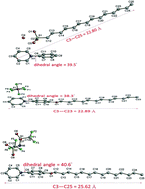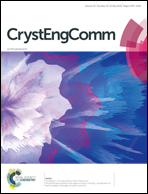Effect of counter ions on the mesogenic ionic N-phenylpyridiniums†
Abstract
Two series of ionic liquid crystals (ILCs) derived from N-phenylpyridinium 1–2 were prepared and their mesomorphic properties were investigated. A versatile and effective method was developed to prepare these ionic compounds 2-X from their precursor chloride 2-Cl. X-ray crystal structure analyses of three single crystals revealed that a sandwiched head-to-head or bilayer lamellar structure induced by H-bonds in the solid state was observed. The anion was proximally intercalated near the head group. Weak H-bonds were induced and attributed to the formation of mesophases. The type of counter anions has a significant influence on the stability of the mesophase, ΔTSmA = 221.3 (2-Cl) > 213.1 (2-SCN) > 173.9 (2-BF4) > 85.4 (2-RSO3) > 63.8 (2-PF6) > 41.4 °C (2-OTf) for all derivatives with n = 12. The compound 2-BF4 (n = 16) has the widest temperature range of the smectic-A (SmA) phase (i.e., ΔTSmA = 234.3 °C), significantly broader than those of other reported ILCs. Also compound 2-NTf2 (n = 14) was the first phenylpyridinium-based ILC and compound 2-SCN (n = 16) was the room temperature ILC. The X-ray diffraction experiments confirmed the structure of the SmA phase and it showed a strong dependence of bilayer structure with various anions. A linear correlation plot (R2 = 0.9643) of the clearing temperatures of compounds 2-X with the calculated effective radius (Reff) of the anions was obtained.



 Please wait while we load your content...
Please wait while we load your content...